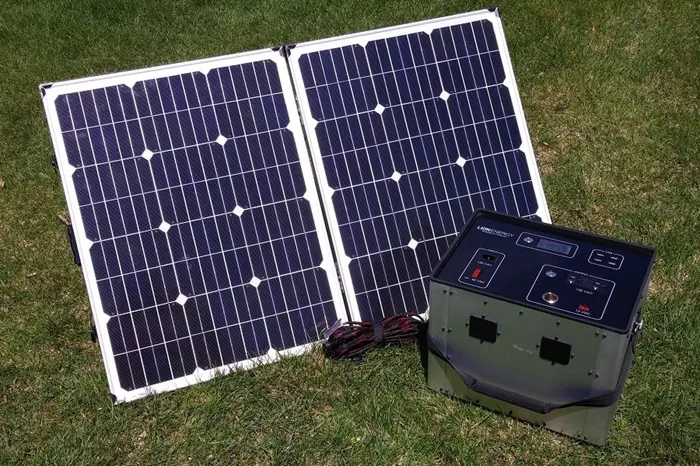Solar generators are compact, portable devices that capture solar energy through photovoltaic panels and convert it into electrical power. Unlike traditional generators fueled by gasoline or diesel, solar generators produce clean and renewable energy without emissions or noise. They typically consist of solar panels, a charge controller, a battery bank, and an inverter. These components work together to capture, store, and convert solar energy into usable electricity for various household applications.
Components of a Solar Generator System
Solar Panels
Solar panels are the primary component of a solar generator system, responsible for capturing sunlight and converting it into direct current (DC) electricity. Panels are typically made of silicon-based photovoltaic cells, which generate electricity when exposed to sunlight. The size and efficiency of solar panels influence the amount of electricity generated.
Charge Controller
The charge controller regulates the flow of electricity from the solar panels to the battery bank. It prevents overcharging of batteries, which can reduce their lifespan, and ensures efficient charging by optimizing the voltage and current levels.
Battery Bank
Batteries store the electricity generated by solar panels for later use, providing power during periods of low sunlight or at night. Common types of batteries used in solar generators include deep-cycle lead-acid batteries, lithium-ion batteries, and increasingly, advanced battery technologies like nickel manganese cobalt oxide (NMC) batteries.
Inverter
The inverter converts the direct current (DC) electricity stored in the battery bank into alternating current (AC) electricity, which is used by most household appliances and electronics. Inverters come in various sizes and power ratings to accommodate different loads and usage scenarios.
Sizing Your Solar Generator
Determining the appropriate size of a solar generator involves assessing your household’s energy consumption and the specific appliances you wish to power. The process typically involves calculating your daily energy needs in watt-hours (Wh) or kilowatt-hours (kWh) and matching it with the capacity of the solar panels and battery bank. Factors such as geographic location, sunlight hours, and seasonal variations in sunlight intensity also influence sizing considerations.
Powering Household Appliances with Solar Generators
Solar generators can power a wide range of household appliances, from small electronics like smartphones and laptops to larger appliances such as refrigerators, televisions, and even power tools. Understanding the power requirements (in watts or kilowatts) and operating characteristics of each appliance is crucial for determining compatibility with a solar generator system.
Managing Energy Storage and Usage
Efficient management of energy storage and usage is essential for maximizing the effectiveness of a solar generator. Strategies include:
Battery Management: Monitoring battery levels and charging patterns to optimize battery lifespan and performance.
Load Prioritization: Prioritizing essential appliances and distributing energy usage throughout the day to match solar generation peaks.
Energy Monitoring Systems: Using monitoring devices to track energy production and consumption in real-time, allowing for proactive adjustments and optimizations.
Integrating Solar Generators with Existing Systems
Integrating a solar generator with an existing power system, whether grid-tied or off-grid, requires careful planning and consideration of compatibility issues. Grid-tied systems allow solar generators to supplement grid power, potentially reducing electricity bills through net metering arrangements. Off-grid systems provide complete independence from the utility grid, relying solely on solar power and battery storage.
Benefits of Using Solar Generators for Home Power
The advantages of utilizing solar generators for household electricity needs include:
Environmental Sustainability: Solar generators produce clean energy, reducing greenhouse gas emissions and dependence on fossil fuels.
Cost Savings: Over time, solar generators can lead to significant savings on electricity bills, especially in areas with high electricity rates or unreliable grid power.
Energy Independence: Off-grid solar generators provide resilience against power outages and grid failures, ensuring continuous electricity supply.
see also: 3 Best Solar Generators Under $1000 For 2024
Limitations and Challenges
Despite their benefits, solar generators have limitations and challenges that potential users should consider:
Initial Investment: The upfront cost of purchasing and installing a solar generator system can be substantial, although prices have been decreasing with technological advancements.
Intermittent Power Supply: Solar generators rely on sunlight for energy generation, making them less reliable during cloudy weather or at night without sufficient battery storage.
Maintenance Requirements: Regular maintenance, such as cleaning solar panels and monitoring battery health, is necessary to ensure optimal performance and longevity.
Case Studies and Real-Life Applications
Examining real-life examples of households successfully using solar generators provides practical insights and inspiration for prospective users. Case studies highlight different setups, challenges encountered, and solutions implemented to optimize energy efficiency and reliability.
Planning and Installing a Solar Generator System
For homeowners interested in installing a solar generator system, careful planning and execution are essential:
Equipment Selection: Choosing high-quality solar panels, batteries, inverters, and charge controllers based on performance, reliability, and compatibility.
Site Assessment: Evaluating the solar resource potential, shading issues, and available space for solar panel installation.
Safety Considerations: Adhering to safety guidelines and regulations during installation, including proper grounding and electrical wiring practices.
Future Trends and Innovations in Solar Power
The future of solar power and solar generators is promising, with ongoing advancements focusing on:
Increased Efficiency: Improving the efficiency of solar panels and inverters to maximize energy output from sunlight.
Energy Storage Solutions: Developing innovative battery technologies with higher energy density, faster charging capabilities, and longer lifespan.
Smart Grid Integration: Integrating solar generators into smart grid systems for enhanced grid stability, demand response capabilities, and energy management.
Related topics:
- Power Up Your Home: The Ultimate Guide To Choosing The Best Backup Diesel Generator
- Diesel VS Petrol Generators: Which Is Better For Your Needs?
- The Role Of Solar Generators In EV Charging

